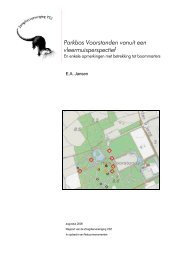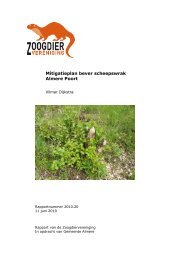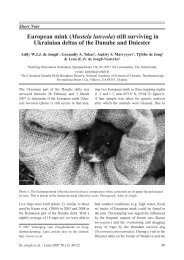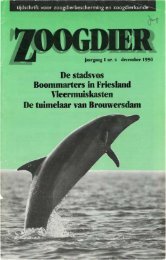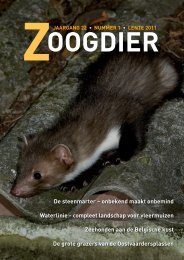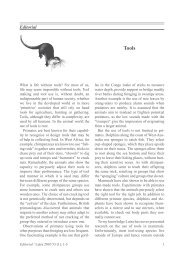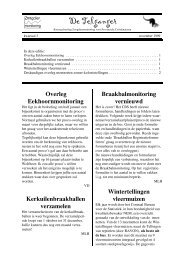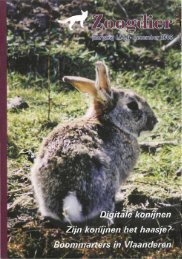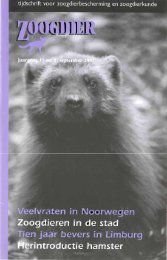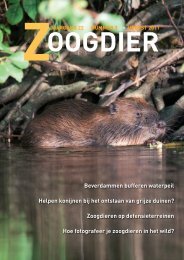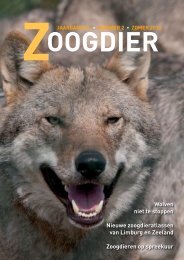binnenwerk 48-2-2005 - De Zoogdiervereniging
binnenwerk 48-2-2005 - De Zoogdiervereniging
binnenwerk 48-2-2005 - De Zoogdiervereniging
You also want an ePaper? Increase the reach of your titles
YUMPU automatically turns print PDFs into web optimized ePapers that Google loves.
Bennet & van Olivier (1822) wrote (all citationsin the original Dutch) “Gelijk er voldoenderedenen zijn, om de ware kat onder de voormaligeNederlandsche dieren te kunnen rekenen,zoo meent men op goede gronden dezelve thansals uit Nederland verjaagd of voor geheel uitgeroeidte moeten houden, ...” [italics by Bennet& van Olivier] (“There are reasons to considerthe wildcat to be a former part of the Dutch nativefauna, and it is generally thought that thespecies has been extirpated from the Netherlands.”).Schlegel (1862) mentions that there isno evidence “dat de wilde Kat in vroegere tijdenhier te lande geleefd heeft; ofschoon dit niet onwaarschijnlijkis, daar zij nog heden in hetnaburige Duitschland, en in het Ardenner woudzelfs vrij algemeen voorkomt.” (“... that thewildcat actually lived in the Netherlands, althoughits present occurrence in neighbouringGermany is not improbable, while the speciesmay even be common in the Ardennes.”) And,next, quoting Van Bemmelen (1864), the wildcathas “bijna zeker in vorige eeuwen […] ons landbewoond, hoewel [hem] gene bepaalde opgavenbekend zijn. <strong>De</strong> berigten van het schieten vanwilde Katten, die men zelfs nu nog enkele malenin nieuwsbladen vermeld vindt, betreffen verwilderde[italics by Van Bemmelen] voorwerpen.”(“... almost certainly lived in our country informer centuries, although records are unknown.Reports on shooting of wildcats, which may stillbe found in newspapers, concern stray animals.”)So, there is nothing new under the sun.The comprehensive Dutch mammal handbookby IJsseling & Scheygrond (1943) does not addany further information on wildcats to the 19thcentury sources. Thissen & Hollander (1996) donot include the wildcat in their review of the statusof mammals in the Netherlands since 1800.Thus we have not been able to identify anyrecords about the occurrence of the wildcat in theNetherlands between Roman times up to 1950.This is an indication that the wildcat did not occurin the Netherlands in post-Roman times. Adifferent approach to the subject, that of undertakinga study on place names associated withwildcats (as has been done for beavers, badgersand otters by Van Wijngaarden (1966) and VanWijngaarden & Van de Peppel (1964, 1970))does not seem very useful because of the confusionthat would be caused by the existence of thedomestic cat. This would make it almost impossibleto attribute a place-name unequivocally to awildcat. Moreover there are cat place-names thathave nothing to do with this animal (L. Brouwer,personal communication).Much has been published on the (pre)historicaloccurrence and disappearance from theNetherlands of other mammal species of interest,like the beaver (Castor fiber), the otter (Lutra lutra),the lynx (Lynx lynx), the wolf (Canis lupus),the brown bear (Ursus arctos), and the wild boar(Sus scrofa) (see: van Wijngaarden 1966, vanWijngaarden & van de Peppel 1970, de Rijk1987, Pelzers 1988, Verhagen 1989, van deVeen & Lardinois 1991, Mulder 1992, Ervynck1993). It is remarkable that wildcat was neverdiscussed in the debate about the (re)introductionof carnivores, such as the wolf and the lynx,in the Netherlands. Some of these species havenow been purposefully re-introduced into theNetherlands.In Germany the remains of wildcats from historicaltimes have been found at excavations andin caves from the Middle Ages, but also from the19th century (Piechocki 1990). Piechocki (1990)mentions that after the Middle Ages, massivedeforestation led to the range of the wildcat inGermany being restricted to wooded hill ranges.More recent records, from Westphalia, theeastern part of the German federal state of Nordrhein-Westfalen,show evidence of the presenceof wildcats in hill ranges, such as the TeutoburgerWald and the Sauerland in the nineteenth and earlytwentieth centuries (Feldmann 1984). In Belgiumthere is evidence that the wildcat was presentafter the Middle Ages; Tack et al. (1993)mention that, in the period 1586-1783, there were64 occasions when wildcats were registered inthe bounty administration for vermin in the viscountcyof Gent, although the wildcat itself hadno bounty on its head. So the wildcat appears tohave survived for much longer in neighbouringcountries that it did in the Netherlands.72 Canters et al. / Lutra <strong>2005</strong> <strong>48</strong> (2): 67-90
Possible occurrence in the 1950s and 1960sThere are a number of striking records of cats inthe wild in the Netherlands that date from the1950s and 1960s. Van Bree (1959, 1963), laterthe curator of mammals at the Zoological Museumof Amsterdam, and several other authors,have discussed these records in publications(Anonymous 1959, 1961, 1962, 1965, de Haan1970). At this time it was legal to kill feral domesticcats throughout the year. Some cats shotin this period are reported to have had characteristicssimilar to those of a wildcat, for exampletheir coat colour, pattern and a bushy ringed tail.Incited by the first uncertain observations andthe publications in this period the public waspossibly more eager to find ‘wildcats’. However,in all those cases where the animal could bechecked for internal characteristics (see above),it appeared that at least one crucial feature didnot allow identification as a true wildcat.Thus, no single record of the wildcat in the1950s and 1960s can be proven to be completelyconclusive. Van Bree et al. (1971) eventuallyconcluded that there was no indisputable evidenceto support the occurrence of the wildcat inthe Netherlands at this time. Consequently thepresence of this carnivore in the Netherlands remainedunsupported. Yet, one young tomcatcaught close to Ter Worm Castle, west ofHeerlen, in 1963 (presently in the collection ofthe Natuurhistorisch Museum Maastricht, Maastricht:NHM St.951 z) was claimed to be a wildcat(e.g. Moonen 1975, Vergoossen & van derCoelen 1986). However, as Van Bree et al.(1971) argued its measurements did not excludeit being a domestic cat (see also: Moonen 1975).In the text of the first mammal atlas of theNetherlands Van Wijngaarden et al. (1971) mentiononly the dubious record from Heerlen (vanBree 1963), although the reference list also citesa publication about an alleged wildcat at Haelen(van Bree 1959).It is thought that at this time there might havebeen a small, but stable, population in theRothaar hill range (Sauerland) in Westphalia,Germany (Feldmann 1984).Possible occurrence in the 1970s, 1980s andearly 1990sWe could find no records of wildcats in theNetherlands in the 1970s and 1980s. The secondmammal distribution atlas of the Netherlands(Broekhuizen et al. 1992), which covers the period1970-1988, does not mention the wildcat atall. Yet, Lange et al. (1994) stated that the wildcat,if not already present in the Netherlands, was approachingthe borders of our country. Evidencefor this statement stems from the finding of footprintsby one of the authors (A. van Diepenbeek)on 6 May 1991, which were attributed to wildcat.This was at Eyneburg Castle near Hergenrath inBelgium, just over six kilometres from the Dutchborder, south of Vaals. Broekhuizen (1996) takesmore or less the same line, speaking about “thesteady expansion of the distribution area of thewildcat in the direction of southern Limburg, theNetherlands”. Parent (1986) however, in his publicationon the current occurrence and legal statusof carnivores in Belgium and the Netherlands, onlymentions the wildcat in passing, in the contextof it only being indirectly protected by the DutchHunting Act.In the forest of Reichswald in Germany, justacross the border near Nijmegen, Gerard Müskensand one of the authors (J. Thissen) found a roadcasualty cat (NL RD-coordinates: 203/417) on 19April 1987. Van Bree (personal communication),who examined the badly damaged remains(ZMA 23.331), identified this animal as a hybridbetween a wildcat and a domestic cat.In the course of the 1990s there were rumouredsightings of wildcats on several occasionsin southern Limburg, the Netherlands. Wemanaged to trace these rumours to observationsmade in the surroundings of Vaals, the mostsoutheastern part of Limburg, by Leo Backbier.As Backbier died in 2004, we have not beenable to make further inquiries. His zoologicalarchives are not currently accessible (E.Gubbels, personal communication) and, as far aswe could find out, nothing has been published onthese observations. There are no photographs ofany wildcat traces. Since there is no physical orCanters et al. / Lutra <strong>2005</strong> <strong>48</strong> (2): 67-90 73
ecorded evidence we cannot confirm these observations(however see below, under the heading‘Possible origin’).Recent, but uncertain, records from theNetherlands and adjacent areas in Germanyand BelgiumOur investigations have led us to unearth somemore unverified records (see also table 2):● On 11 March 1995 a road casualty cat wasfound near Maasbree (province of Limburg).The marbled pattern, massive body, weight(5.5 kg), black tipped tail with five rings (althoughtapered), large head, pink nose leatherand conspicuously white whiskers all indicateda wildcat. Its external measurements were:head and body length 52 cm; tail length 31cm; hind foot length 12 cm (excluding nails);hind foot width: >35 mm; ear length 52 mm. Ithad a light cream coloured, not sharply delimited,bib. As the cat had small testicles and thecanine teeth showed no wear it was probably ayoung animal. Since the tail length was >50%of the head and body length, it was assumed atthe time to be a hybrid, following Halthenorth(1957). However, Schauenberg (1977) andPiechocki (1990) have shown that relative taillength is not a distinguishing characteristic.Most wildcats have tails that measure morethan half of the head and body length. Nosamples were collected for later internal investigationor DNA analysis.● On 1 March 2001 a road casualty cat was foundat Stramproy (province of Limburg). GerardMüskens and one of the authors (H. Jansman)(both Alterra, Wageningen University and ResearchCentre) performed an autopsy on thebody. It was an adult male, tabby-coloured cat,head and body length 51.2 cm; tail length 27cm; hind foot length (inclusive nail): 11.8 cm;ear length: 58 mm; length of intestinal tract:161 cm; skull: concave glabella, i.e. a hollowbehind the nasal bones; tail: rather thick, but tapered.The conclusion of the autopsy reportread: “Characteristics of wildcat: tail width,partly coat colour; characteristics of hybrid orferal domestic cat: tail length, head and bodylength, colour pattern and length of hind foot.”Samples were retained for later investigation.● On 7 November 2004 a rather robust cat wasobserved in the Millingerwaard near Nijmegen.The animal had a bushy, more or lessblunt tail with a black tip and a number of blackrings and was extremely shy (see also: Wijsman1998). Notably this location is close towhere the Groenlanden cat was later found (seebelow); approximately eight kilometres furthereast along the river Waal and within the sameextensive rough and diverse riverbank habitatthat lies between Nijmegen and the Germanborder.We have been unable to positively identify anyrecent records of wildcat in the area of Germanybetween the Dutch Province of Limburg and theRhine (M. Trinzen – Biostation Euskirchen, Eifel,personal communication; R. Hutterer – UniversitätBonn, personal communication). In Belgium,the Flemish Institute for Forestry andGame Management has, since 1996, been systematicallycollecting dead carnivores. It has beenasked on several occasions to identify a possiblewildcat. However, each time it concluded that itwas not a wildcat. These conclusions were basedon a combination of characteristics: coat colour,tail, lower jaw, skull sutures, and glabella (K. Van<strong>De</strong>n Berge, personal communication).Records of wildcat in theNetherlands since 1995The cat found at Groenlanden, nearNijmegenOn 13 June 1999 a dead cat was found nearGroenlanden, a hamlet near Nijmegen (see alsotable 2). On the spot photographs were taken ofthe corpse, which show the following characteristics(see: photographs 2 and 3): the body isbulky to robust; there is a faint striping of thecoat, which looks thick and long-haired; the tailis thick and blunt and it has a black tip and 3-474 Canters et al. / Lutra <strong>2005</strong> <strong>48</strong> (2): 67-90
Table 2. Uncertain and certain records of wildcats (Felis silvestris) in the Netherlands since 1995.Status Date Type RD-coordinates Sex Most striking and / or Material Observerof record convincing features (for collectedmore details see text)uncertain 11 III 1995 road casualty 198/374 coat pattern, tail, no Annemarie van Diepenbeekbody size, whiskers,nose leather1 III 2001 road casualty 174/356 coat pattern (however collection Alterra, Theo van den Berkmortelexternal sizes indicate Wageningendomestic cat) Universityand ResearchCentre7 XI 2004 sighting 196/431 ? tail, size, behaviour – Martin van Lokvencertain 13 VI 1999 found dead 191/431 ? intracranial volume, skull (private Kor Goutbeeklower jaw collection)1 XI 2002 road casualty 197/308 coat pattern, external skin (collection no longer traceablemeasures Klaas Arends,Heerlen)1 III 2004 caught and 169/376 DNA pattern some hair Mari de Bijl (Landscape ofsamples Brabant Trust) and Anne-(collection A. van marie van Diepenbeek releasedDiepenbeek,Veghel)Canters et al. / Lutra <strong>2005</strong> <strong>48</strong> (2): 67-90 75
lack rings; the muzzle has a light colour aroundthe mouth. On the original colour photographsthe coat looks light yellow-greyish. According tosite warden, H. Woesthuis (personal communication),this cat may have lived in this area forabout two yearsOnly the skull of the cat was retained and it isnow in a private collection. After examination ofthe skull Van Bree (personal communication)confirmed (on 1 October 2001) that, in view ofits measurements and the intracranial volume, itwas definitely a wildcat. On 31 May 2004 two ofthe authors (K. Canters & H. Jansman) measuredthe skull again. In addition a tissue sample forDNA analysis was collected from the root channelof one of the molars (see below).The skull has the following measurements (inmm): condylobasal length: 92.9; length of mandible:68.1; teeth row length (lower jaw): 34.3;Photograph 3. Tail of the wildcat (Felis silvestris)found on 13 June 1999 near Groenlanden (near Nijmegen):the tail is thick and has four, more or less,clearly visible rings and a blunt and black end. Photograph:Kor Goutbeek.teeth row length (upper jaw): 32.1; interorbitalconstriction: 19.8; postorbital constriction: 34.2;brain case breadth: 73.0; molar row length(upper jaw): 23.0; molar row length (lowerjaw): 19.7; intracranial volume: 40.0 cm 3 . TheSchauenberg index is 2.3. Furthermore, put in avertical position, the jaw of this cat stayed upright.The cat found at Vaalsbroek, southernLimburgPhotograph 2. The wildcat (Felis silvestris) found on13 June 1999 near Groenlanden (near Nijmegen):the pattern of the trunk is visible, but not rich incontrast. On the original photograph the light basiccolour is visible: yellowish grey; note the lightcoloured chin and corners of the mouth. Photograph:Kor Goutbeek.On 1 November 2002 a female road casualty catwas found close to Vaalsbroek Castle near Vaals(south of Limburg) (see also: table 2). As theanimal was crushed, only the skin was collected.The fur of this cat has the following characteristics(see also: photographs 4, 5, and 6): a longhairedand woolly coat with very thick underfur;coat colour: uniform salt-and-pepper with a yellowishtinge; blunt tail with black tip, on the distalend 4(-5) black continuous rings; between76 Canters et al. / Lutra <strong>2005</strong> <strong>48</strong> (2): 67-90
Photograph 4. Side-view of the wildcat (Felis silvestris) found on 1 November 2002 as a road casualty near Vaalsbroek(province of Limburg); note the light colour and faint stripes, the white muzzle and bib, and the thick tailwith four clearly visible rings and a black knob. Photograph: Annemarie van Diepenbeek.shoulders and hips a prominent dorsal stripe;sole of hind foot partly with black fields aroundthe toes, white spots between the pads on all fourfeet; all claws of a light keratin colour; whiskers:white but not conspicuously large; some central,smaller whiskers: black or with a black base;nose leather: light colour; muzzle around mouth:light colour; small white bib. Some externalmeasurements were also taken: head and bodylength: circa 61 cm; tail length: 22.5 cm (i.e.without hairs); hind foot: circa 14.5 cm; earlength: 39 mm (i.e. without hairs).Photograph 5. Dorsal view of the wildcat (Felis silvestris)found on 1 November 2002 as a road casualtynear Vaalsbroek (province of Limburg); note the faintnarrow and black interrupted dorsal stripe. Photograph:Klaas Arends.Canters et al. / Lutra <strong>2005</strong> <strong>48</strong> (2): 67-90 77
Photograph 6. Tail of the wildcat (Felis silvestris) found on 1 November 2002 as a road casualty near Vaalsbroek(province of Limburg); note the tick tail, the more or less clearly visible rings and the black knob. Photograph:Annemarie van Diepenbeek.The cat caught near Heeze (province ofNoord-Brabant)On the 1st of March 2004 a cat was caught ina wire trap cage in a coop at the edge of the“Hubertusbossen” forest, near Heeze, in theProvince of Noord-Brabant (see also table 2).This forest, located directly east of the townof Heeze, is a nature area of 750 ha, mainlyconsisting of varied deciduous and coniferouswoods. The surroundings are diverse, withbrook valleys, pastures, arable land and theStrabrechtse Heide, a wood and heathland areaof 1,100 ha. The trap cage was set becausein previous nights two chickens had been killedin the hen house and partially eaten. Thetrap cage was baited with one of the dead chickens.Once trapped the cat behaved extremely shylyand snarled furiously. It was anaesthetised by thelocal veterinarian to enable one of the authors(A. van Diepenbeek) to measure the animal, andcollect a hair sample for DNA analysis. Later thesame evening the animal was released in theHugterheide, a nature area about eight kilometresfrom where the animal was captured. Theowner of the chickens objected to the cat beingreleased close to where it was trapped and hepromised to improve the fencing of the chickenrun in order to prevent predators from breakingin.Physically this was a rather meagre tomcat ofabout one year old (see photographs 7-9) withdeveloped, but not large, testicles. The yellowishgrey coloured fur was more or less clearly visiblystriped; the tail was rather thick and blunt,with a black tip and with 3-5 black rings distributedover the whole tail, the nose leather was78 Canters et al. / Lutra <strong>2005</strong> <strong>48</strong> (2): 67-90
Photograph 7. Side-view of thewildcat (Felis silvestris) trappedon 1 March 2004 near Heeze(province of Noord-Brabant): therelatively short and thick tail hasthree or four rings (see also: photograph8) and a black end; the patternon the trunk is not strongly defined;note the whitish lower lipand white chest. Photograph: Annemarievan Diepenbeek.Photograph 8. Back and side-viewof the wildcat (Felis silvestris)trapped on 1 March 2004 nearHeeze (province of Noord-Brabant):one can see a faint, dark dorsalstripe and the ring pattern on thetail. Photograph: Annemarie vanDiepenbeek.Photograph 9. Front-view of headof the wildcat (Felis silvestris)trapped on 1 March 2004 nearHeeze (province of Noord-Brabant):white whiskers, nose leatherand lower lip light coloured and awhite bib. The eyes were treatedwith salve during the anaesthesiato prevent them from drying out.Photograph: Annemarie van DiepenbeekCanters et al. / Lutra <strong>2005</strong> <strong>48</strong> (2): 67-90 79
light coloured; the muzzle was white around themouth and the animal had a white bib; the blackdorsal stripe did not continue along the tail. Ahair sample was collected for DNA analysis (seebelow). The following external measurementswere taken, total length: at least 85 cm; head andbody length: 52.5 cm; tail length: 31 cm (includinghair: 33 cm); hind foot length: 13.8 cm (includingnails: 14.6 cm): ear length 60 mm (withhair: 68 mm); weight: 3700 g.In the course of <strong>2005</strong> it became clear that thiswas an unintentional introduction. The cat wasfound as a young stray in the summer of 2003 ina forest in the Vosges mountains (France) andwas taken away to Heeze (The Netherlands), inthe belief that it was a domestic cat. It prosperedin its new home in Heeze until disappearing oneday in the winter of 2004.DNA analysesTissue material from two cats, the ones fromGroenlanden and from Heeze was available forDNA analysis. These samples had been conservedin an ATL-buffer. DNA was extractedfrom these samples at Alterra Research Institute,using the DNeasy Tissue Kit, following the protocolof the manufacturer (Qiagen Inc.). Tongswere used to pulverize the sample taken from theroot channel of the Groenlanden cat in order toget better access to the DNA. A third sample ofDNA, from a domestic cat, was extracted for referencepurposes.Since the wildcat and domestic cat are closelyrelated, it is presently not easy to make a geneticallyclear distinction between them. However,we can analyse the DNA on microsatellites, becausethere are differences in the alleles and theirfrequencies. This requires access to a comprehensiveDNA collection, containing material ofmany wild and domestic cats, and preferably ofwildcats originating from close to the Netherlands.Since Alterra does not have such a database, we sent the samples for further analysis tothe Instituto Nationale per la Fauna Selvatica‘Lozano Emilia’ in Bologna, Italy (for moretechnical details see: Jansman et al. 2003, Leciset al. 2006). Their DNA collection includes samplesof wildcats from the Eifel hills.The genetic distance of each sample was measuredand the samples were assigned to the mostrelated genetic cluster, using the computer programmeSTRUCTURE (Pritchard et al. 2000).The outcomes of such an analysis with the materialof different cats should give two clusters,one with wildcat, the other with domestic cat.The overlap of the clusters illustrates the geneticresemblance and may be indicative of the presenceof hybrids. Although this technique doesnot provide 100% certainty on the identity of aspecimen, the degree of uncertainty is muchsmaller if the tested sample lies outside the overlaparea of both clusters.The reference sample of the domestic cat wasinside the domestic cat cluster and only bore a20% resemblance to the wildcat cluster. The hairsample taken from the cat from Heeze had a 90%fit with the wildcat cluster, providing us with anotherargument to identify this cat as a wildcat. Itwas not possible to obtain results from theGroenlanden cat, probably because the DNAmaterial was too degraded, owing to the methodof preservation that had been used.DiscussionThe occurrence of the wildcat in theNetherlandsBased on the intracranial volume of 40.0 cm 3 , thecat found at Groenlanden can be positively identifiedas a wildcat, even though failure of the DNAanalysis of the root channel sample means thatthis identification could not be confirmed genetically.As all the external characteristics of theVaalsbroek cat indicate a wildcat (see also: table1), we also consider this animal to be a wildcat.Although we cannot exclude the possibility thatthese two positive records are also cases of introduction,intentional or not, we think that this is unlikely.For example, Heike Weber (of NordhornZoo, Germany) informed us that there had been:“definitely no escapes from our zoo since 1990”.80 Canters et al. / Lutra <strong>2005</strong> <strong>48</strong> (2): 67-90
The DNA analysis of the hair sample of the catcaught at Heeze convincingly demonstrates thatthis can be considered to be a true wildcat. However,the information on the history of this animalshows that this case was an unintentional introductionfrom the Vosges, and not a result ofspontaneous settlement.We do not consider the other observations,over the past decade, of cats that show some resemblanceto the wildcat, to be positive records.Possibly these are hybrids. These observationsdo however provide circumstantial evidence ofthe presence of wildcat in the area. Moreover,the appearance of hybrids is more likely in theevent of the incidental occurrence of individualpure wildcats.We strongly recommend that, from now onwards,anyone making field observations of yellowishto brownish grey-coloured cats in theNetherlands to be alert to the possibility of awildcat. We urge that such observations shouldbe meticulously recorded, and reported to thedatabase of the (Dutch) Society for the Study andConservation of Mammals (‘<strong>Zoogdiervereniging</strong>VZZ’) in Arnhem. This will help document thepattern of future arrivals of wildcat in theNetherlands, and help underpin future analysisand research. The external characteristics thatdistinguish wildcats from domestic cats can befound in table 1.We would like to stress that many of the characteristicslisted in table 1 are gradual differences.The possible occurrence of hybrids complicatesthis matter even more. One has to try tofind out as much as possible about the relevantcharacteristics to be able to definitively identifythe animal. It is extremely difficult to in the fielddistinguish a wildcat from a domestic cat.Settlement in the NetherlandsTwo positive records, and a few observations ofpossible hybrids, are not sufficient proof of thewildcat settling, or taking up permanent residencein the Netherlands. For that, evidence ofreproduction would be required, preferably severalcases. In this respect the difficulty of distinguishingyoung wildcats from young tabbycoloureddomestic cats poses a problem. Youngwildcats have a prominent pattern of stripes,whereas in adult wildcats this pattern becomesless pronounced, as the guard hairs grow(Piechocki 1990).Possible originThe southeast of the Netherlands borders on theGerman federal state of Nordrhein-Westfalen (tothe east) and Flemish district of the Voerstreek(to the south). The south of the Voerstreek is directlyadjacent to the heavily wooded Ardennesin Wallonia. Vandendriessche & Verkem (2004)mention that between 1987 and 2002 the rangeof the wildcat in Wallonia came close to theVoerstreek, although they point out a lack ofconfirmed observations in the Voerstreek. Libois(1991) mentions that the wildcat was frequentlyobserved in the Hautes Fagnes, about 25 kmaway from the Dutch border of southern Limburg,in the 1970s and 1980s. The previouslydiscussed record of foot prints of a wildcat nearHergenrath, six kilometres south of the Dutchtown of Vaals, shows that the species is presentjust south of the border. The find of a wildcatnear Vaalsbroek corroborates this. However,there is no information from this period (the1990s) on the occurrence of the wildcat alongother parts of the Dutch-Belgian border area(Vandendriessche & Verkem 2004).Although it seems most likely that wildcatsfrom the Ardennes move north and enter theNetherlands through the Voerstreek, it is alsopossible that they come directly from the Eifelhills. Groenlanden, the location of one record, isfar north of the Ardennes and the urban agglomerationof Sittard-Geleen lies between the two. Ittherefore seems more probable that this wildcatcame from the German area in the east, forexample from the Hürtgenwald (Nord-Eifel).This is only about 15 km from the Dutch-German border at Vaals, and wildcats are knownto exist here (www.biostationeuskirchen. de;viewed 18 November <strong>2005</strong>). This animal mightpossibly have been born in the Eifel hills, butCanters et al. / Lutra <strong>2005</strong> <strong>48</strong> (2): 67-90 81
could not find a territory to occupy there andwhen moving north between the rivers Maas andRhine may have found the river Waal in its way.On 20 March 2002 the website www.biostationeuskirchen.dementioned a big increase ofthe wildcat in the Eifel hills that had increasedfrom 300 specimens in 1990 to 1000 in 2000. On26 January <strong>2005</strong> the same website mentioned theoccurrence of 200-250 wildcats in the Nord-Eifel, the part of the Eifel that lies within Nordrhein-Westfalen.According to Vogt (1985) andVogt & Grünwald (1990) the population size inRheinland-Pfalz (the German state that coversthe most of the Eifel hills) did not change in the1970s and 1980s. Consequently increases in thewildcat population may be a relatively recentphenomenon that could have started as late as the1990s.Although wildcats are sporadically observedin the less wooded area just north of the Eifel, itseems that even five kilometres of open agriculturalland presents a large obstacle for the wildcat(M. Trinzen, personal communication). Thismakes the possibility of the wildcat originatingin the Eifel hills seem less probable. However, inview of the number of woods between the Germanborder of the provinces of Limburg and theRhine this possibility cannot be excluded.The occurrence of a wildcat at Vaalsbroek canbe explained in a similar way. The woods in theneighbourhood of Vaalsbroek and Vaals, such asthe Vijlenerbosch and the Malensbosch (togethercirca 800 ha), are more or less directly connectedto the large complex of woods south of Aachen,consisting of the Aachener Wald and the Preusswaldin Belgium (together circa 3000 ha). Thiscomplex of woods can be considered as anextension of the woods of the Eifel hills and theArdennes. It would relatively easy for a wildcatto move from its habitat in the Eifel to the northwestthrough these inter-connecting woods.Raimer (1994) and Hemmer (1999) show thatthe wildcat does occur south of Aachen. Thiswould lend credence to the reported observationsby Leo Backbier in the surroundings of Vaals(see above).Possible explanations for the recent recordsThe two recent records of the wildcat in thesoutheast of the Netherlands after a period ofmany centuries without confirmed records requireexplanations. Although we can not fullyexplain these phenomena, and cannot entirelyexclude coincidence, we do believe that there arefeasible explanations.At the outset we should state that there are noindications that the two observations were theresult of increased activity by observers. Thecurrent probability of observation probabilitydoes not seem to be any higher than in the 1970sand 1980s. Rather, we propose the followingplausible explanations for these sightings.1. More and better habitat. More natural successionin nature areas, especially woods, offersmore cover and a more diverse structure. Sincethe first National Nature Policy Document(1990), the area of nature areas in the Netherlandshas grown. Hundreds of hectares of naturalhabitat have been created over the last decade inthe nature development area of Gelderse Poorteast of Nijmegen. This may have played a role inthe case of the wildcat of Groenlanden. This areawas formerly open agricultural land, of no interestto the wildcat; Stahl & Leger (1992) emphasisethe importance of extensive continuouswood complexes for the wildcat in the northeastof France.2. Changing management. There has been ageneral hunting ban in many nature reserves inthe Netherlands, a specific hunting ban for thewildcat in Germany (1934) and Belgium (1973)and a general decrease of illegal hunting, trappingand killing in all three countries. In 1996 thewildcat had been added to the list of protectedanimal species of the <strong>De</strong>cree on Protected AnimalSpecies under the Nature Conservation Actof 1967, superseded in 2002 by the new Floraand Fauna Act.3. Increasing mutual tolerance between manand wild animals. There has been a change ofhuman attitudes to wild animals, which are notconsidered to be as dangerous or threatening asbefore, and often even arouse positive interest82 Canters et al. / Lutra <strong>2005</strong> <strong>48</strong> (2): 67-90
(e.g. the beech marten (Martes foina), thatchanged its ‘hostile’ niche of farms in the 1980sinto more ‘hospitable’ ‘green city quarters’).This change might have been noticed by the animalsthemselves, leading to the animals feelingthe need to maintain less distance from humans,and other behavioural changes such as a greateracceptance of the presence of domestic animals,noise, and human disturbance.4. Overflow from adjacent areas. Hemmer(1999) mentions that existence of healthy populationsof wildcat in Europe for example, in Germanywhere there has been a growth in the wildcatpopulation of the Eifel population (seepreceding paragraph).5. Endogenous causes. Parent (1975) describesthe colonisation of the Ardennes and the BelgianLorraine by wildcats from France and Germanyafter World War II. There seem to be phases, incycles of about ten years, when the populationexpands. Although such an interpretation ishighly speculative, there may also be internal,autonomous causes.Consequences for managementAssuming that the records published in this articleare not mere coincidence – and even if theywere, a coincidental occurrence of the wildcatshould have consequences for management practices– and taking into account that the wildcat isprotected in the Netherlands, nature managementorganisations have a new, strictly protected,species to deal with. The hunting communityalso has a problem, since the wildcat is coveredby section a, which protects “all mammals naturallyoccurring in the Netherlands” (Paragraph 1,article 4 of the Flora and Fauna Act (Anonymous2001)). Paragraph 1 deals with all protected indigenousanimal species. Furthermore the wildcathas a (strictly) protected status under the followinginternational conventions and treaties:1. The Bern Convention (Convention on theConservation of European Wildlife and NaturalHabitats) – Annex II, which deals withstrictly protected fauna species, specificallyincludes the wildcat.2. The Habitats Directive (Council Directive92/43/EEG on the conservation of naturalhabitats and of wild fauna and flora) – AnnexIV, that includes the wildcat, deals with ‘Animaland plant species of community interestin need of strict protection’.3. The CITES Convention (the Convention onInternational Trade in Endangered Species ofWild Fauna and Flora) – Appendix II, that includesthe wildcat, deals with very vulnerablespecies, which are subject to generally strictrules on trade.The Dutch Minister of Agriculture, Nature,and Food Quality wrote a letter to the RoyalNetherlands Shooting Association (KNJV) on 3<strong>De</strong>cember 2003 (Reg.no.: DN.2003/3730) statingthat it is not forbidden to trap and kill feraldomestic cats, provided that it is done with a reasonablepurpose (see also: Anonymous 2002).The Minister stated that in the context of theFlora and Fauna Act, he considers control anddamage prevention to be reasonable goals. However,as has been demonstrated above, it is ratherdifficult to distinguish wildcats from tabbycoloureddomestic cats in the field (e.g: Klinkhamer1974; see also: de Nie 1988, Artois et al.2002). To prevent the shooting of wildcats,whether by mistake or not all relevant partiesshould be informed about the possible occurrenceof wildcats. These relevant parties, whomshould be made aware of and take into accountthe possible presence of wildcats, are primarilysite managers, including Game ManagementUnits and individual hunters. Others who shouldbe included on this list include the authorities involvedin the inspection of hunting: theProvinces, the Fauna Fund and the General InspectionService of the Ministry of Agriculture,Nature, and Food Quality. The explanatoryannex of the ‘<strong>De</strong>cree of <strong>De</strong>signated AnimalSpecies under Article 67 of the Flora andFauna Act’ dealing with pest animal species,as published by the Province of Limburg (see:www.limburg.nl/upload/pdf/Faunabeheerplan_besluit_aanwijzing_exart67_florafaunawet.pdf;viewed 20 <strong>De</strong>cember <strong>2005</strong>), highlights the sporadicoccurrence of wildcats in the NetherlandsCanters et al. / Lutra <strong>2005</strong> <strong>48</strong> (2): 67-90 83
and mentions that it is difficult to distinguish wildcatsand feral domestic cats in the field. The ExecutiveCouncil of the Province of Limburg urgespeople, who want to control feral cats, to verifythat the animal is not a wildcat when a supposedferal cat has been caught or is about to be shot.We cannot exclude the possibility that in orderto prevent the unintentional killing of wildcats itmay become necessary, in the near future, to onlyissue shooting permits under strict conditions. Theneed for correct identification may make the use oflive traps a necessity. A further complication is thedifficulty in establishing whether or not a domesticcat in the field is running wild. Ways of addressingthis problem have been addressed elsewhere (see:Bos 1986, <strong>De</strong> Nie 1988 and Artois et al. 2002).ConclusionsRemains of wildcats found at excavations in thelow-lying parts of the Netherlands show that thisspecies occurred in our country until the RomanPeriod. <strong>De</strong>forestation is a possible cause of itsdisappearance. We do not know of any recordsof the wildcat in the Netherlands in post-Romantimes. There are a number of records from the1950s and 1960s of animals showing some characteristicsof wildcats, but none of these werecompletely verified cases.Based on two confirmed observations, atGroenlanden (1999) and at Vaalsbroek (2002),the wildcat should be listed as a member of ourindigenous fauna. Both internal and externalcharacteristics were used for these identifications.The wildcat of Heeze, trapped and releasedin 2004, was positively identified by means ofDNA analysis. However this record appeared tobe a case of unintentional introduction.We conclude that the two records are not justcoincidental, but indicate an expansion in therange of the wildcat, into the Netherlands. As reproductionhas not been recorded, we cannot yetspeak of a permanent settlement of a populationof wildcats.The two confirmed observations may verywell be forerunners of a more general trend thatis the dispersion of young animals, especiallymales, trying to find vacant territories as a resultof increasing wildcat numbers, especially in itsrange directly southeast of the Netherlands, i.e.in the Eifel hills.For the moment, we can only speculate on thepossible causes of the recent records and an expansionin the wildcat’s range. Plausible explanationsare: 1. The availability of more or betterhabitat. 2. Changes in population management.3. Changes in the relations between the publicand wildcat. 4. The thriving state of the (assumed)source population in the Eifel.In view of the protected status of the wildcat inthe Netherlands it is imperative to adequately informsite managers and hunters about the currentstatus of wildcats in the Netherlands, in order toprevent shooting or killing by other means. Thesame holds for authorities that issue or inspectpermits to control feral and stray cats. Strict protectionof the wildcat is hampered by the existenceof hybrids of wildcat and domestic cat, andlegislation that seeks to control feral domesticcats from running wild. This raises an interestingdilemma for site managers, who on the one handshould prevent the presence of feral domesticcats in order to prevent hybridisation (see e.g.Hubbard et al. 1992, Biró et al. <strong>2005</strong>, Lecis et al.2006), but on the other hand should protect wildcats.Acknowledgements: We would like to thank theowner of the skull of the wildcat found near Groenlandenfor putting the skull at our disposal for closer examination.<strong>De</strong>nnis Lammertsma (Alterra, WageningenUniversity and Research Centre) assisted with the collectionof a root channel sample from this cat. Wewould like to thank Klaas Arends for his great willingnessand hospitality at the examination of the cat ofVaalsbroek, including the collection of hair samples,and for one of the photographs of this cat. We aregrateful to Mari de Bijl (Brabant Landscape Trust) forthis alertness regarding the extraordinary catch of thewildcat at Heeze and his collaboration in the examinationof this cat. We would like to thank Dr. Ettore Randi(Instituto Nazionale per la Fauna Selvatica, Ozzanodell’Emilia, Italy) for his DNA-analyses.For information about records of (alleged) wildcats– or otherwise the lack of records – we thank Reinier84 Canters et al. / Lutra <strong>2005</strong> <strong>48</strong> (2): 67-90
Akkermans, Koen Van <strong>De</strong>n Berge (IBW, Geraardsbergen,Belgium), Dr. Peter van Bree (who also identifiedthe cat found near Groenlanden as a wildcat)(Zoological Museum Amsterdam), Dr. Sim Broekhuizen,Gerard Müskens (who also offered an illustrativephotograph) (Alterra, Wageningen University and ResearchCentre), Walter van der Coelen, Ed Gubbels,Neeltje Huizenga (Natural History Society in Limburg,Roermond), Dr. Rainer Hutterer (Bonn University,Germany), Steven Jansen, Sjeng Jehae (StateForestry Service), Rob van der Laak, Dr. RolandLibois (Université de Liège, Belgium), Martin vanLokven, Johannes Regelink, Manfred Trinzen (BiostationEuskirchen, Germany), Harry Woesthuis, PaulVoskamp (Provincie Limburg) and Dr. MathiasHerrmann (OEKO-LOG, Parlow, Germany).For providing literature we thank Theo Hemelaar(Natural History Museum, Maastricht), Mrs. M.H. vanBuren (Royal Netherlands Shooting Association,Amersfoort), Rita Stockmann (Fauna ProtectionTrust), Bauke Hoekstra, Paul Voskamp, Dr. DieterVogt (Ladenburg, Germany), Dr. Volker Mahnert(Natural History Museum, Genève, Switzerland),Edith de Roos (CML, Leiden), Dr. Leos v Klimes v (Instituteof Botany, Trebon, Czech Republic), Dr. AntonErvynck (VIOE, Brussel, Belgium), Dr. Wim VanNeer (KBIW, Brussel, Belgium), Roel Steverink (NaturalHistory Society in Limburg, Roermond), MachteldSchouten (Public Library Margraten), HansBekker (DWW, <strong>De</strong>lft), J. Vanderheiden (ROB,Amersfoort), J. Borkent (Teylers Museum, Haarlem),and Mrs. A. Dijkstra (WUR, Wageningen). We alsothank Dr. Wietske Prummel (the Biologisch-ArcheologischInstituut, University of Groningen), Dr. JørnZeiler (ArchaeoBone, University of Groningen), FritsLaarman (Archis, Dutch National Service for ArchaeologicalHeritage, Amersfoort), and Theo de Jong(Municipality of Eindhoven) for providing informationon the (pre)historical occurrence of the wildcatand the domestic cat in the Netherlands. For informationon cat place-names we thank Dr. LeendertBrouwer (Meertens Institute, Amsterdam).We would furthermore like to thank HenriWijsman, Bauke Hoekstra and Jacqueline van Alphenfor advice on drafts of the article. Finally we thankboth referees. We trust we have made optimal use oftheir comments.ReferencesAnonymous 1959. Verslag van de maandvergaderingte Maastricht, op woensdag 4 november1959. Natuurhistorisch Maandblad <strong>48</strong> (11-12):131-134.Anonymous 1961. Verslag van de maandvergaderingte Maastricht op 7 september 1960. NatuurhistorischMaandblad 50 (1): 11-17.Anonymous 1962. Verslag van de maandvergaderingte Maastricht op woensdag 7 februari 1962. NatuurhistorischMaandblad 51 (1): 18-20.Anonymous 1965. Verslag van de maandvergaderingte Maastricht, op woensdag 1 december 1965. NatuurhistorischMaandblad 54 (11-12): 145-147.Anonymous 2001. Bekendmaking lijsten beschermdeinheemse diersoorten. Bijlage 1 als bedoeld inartikel 1, onderdeel a, van de Regeling vaststellingbeschermde inheemse diersoorten. Staatscourant220 (13 november): 10.Anonymous 2002. Beheer en schadebestrijding. Overde Flora- en faunawet in Nederland. Ministerievan Landbouw, Natuurbeheer en Visserij, <strong>De</strong>nHaag, The Netherlands.Artois, M., M.-J. Duchene, J.M. Pericard & V. Xemar2002. Le chat domestique errant et haret Felis catus,Linnaeus 1758 (Felis silvestris catus). Encyclopédiedes Carnivores France 18. SociétéFrançaise pour l’Etude et la Protection des Mammifères,Paris, France.Bauer, K. 2001. Wildkatze Felis silvestris Schreber,1995. In: F. Spitzenberger (ed.). Die SäugetierefaunaÖsterreichs: 665-671. Austria Medien Service,Graz, Austria.Bemmelen, A.A. van 1864. Lijst der Zoogdieren, totheden in den wilden staat in Nederland waargenomen.In: J.A. Herklots (ed.): Bouwstoffen vooreene fauna van Nederland. III (3 de stuk): 228-254;III (4 e stuk): 414-417. Brill, Leiden, The Netherlands.Bennet, J.A. & G. van Olivier 1822. Naamlijst van Nederlandschedieren. I. klasse. Zogende dieren,(Mammalia). Natuurkundige Verhandelingen vande Hollandsche Maatschappij der Wetenschappente Haarlem 11: 89-160.Biró, Zs., J. Lanszki, L. Szemethy, M. Heltai & E.Randi <strong>2005</strong>. Feeding habits of feral domestic cats(Felis catus), wild cats (Felis silvestris) and theirhybrids: trophic niche overlap among cat groupsin Hungary. Journal of Zoology, London 266:187-196.Bos, P. 1986. Als de kat gaat zwerven. Argus 11 (1):11-13.Canters et al. / Lutra <strong>2005</strong> <strong>48</strong> (2): 67-90 85
Bree, P.J.H. van 1959. <strong>De</strong> kat uit Haelen. (Een voorlopigemededeling.) Natuurhistorisch Maandblad <strong>48</strong>(9-10): 114-117.Bree, P.J.H. van 1961. On the remains of some Carnivorafound in a prehistoric site at Vlaardingen, theNetherlands. Beaufortia 8 (no 91): 109-118.Bree, P.J.H. van 1963. <strong>De</strong> wilde kat, Felis silvestrisSchreber, 1777, een nieuwe zoogdiersoort voorNederland. Natuurhistorisch Maandblad 52 (2):24-28. [zie ook: pp. 18 en 63-64]Bree, P.J.H. van, P.J.A. Mensch & R.W.M. van Soest1971. Nog eens over wilde katten, verwilderdekatten en huiskatten. Natuurhistorisch Maandblad60 (3): 36-38.Brentjes, B. 1965. Die Haustierwerdung im Orient.Die Neue Brehm-Bücherei, Ziemsen Verlag, WittenbergLutherstadt, Germany.Brinkhuizen, D. & W. Prummel 2004. Archeozoölogischonderzoek wierde Friesestraatweg Groningen.Van Wierden en Terpen (= Mededelingenvan de Vereniging voor Terpenonderzoek) 9: 6.Broekhuizen, S. 1996. Wilde kat en lynx beschermd!Zoogdier 7 (4): 37.Broekhuizen, S., B. Hoekstra, V. van Laar, C. Smeenk& J.B.M. Thissen (red.) 1992. Atlas van de Nederlandsezoogdieren. Stichting Uitgeverij KoninklijkeNederlandse Natuurhistorische Vereniging,Utrecht, The Netherlands.Carmiggelt, A., F.J. Laarman & J.A. Waasdorp 1998.Het archeozoölogisch onderzoek. In: A. Carmiggelt(red.). Romeinse vondsten van de Scheveningsewegte <strong>De</strong>n Haag. <strong>De</strong> dieren- en plantenresten(= Haagse Oudheidkundige Publikaties 3):11-37. Afdeling Archeologie, dienst Stadsbeheer,gemeente <strong>De</strong>n Haag, The Netherlands.Clason, A.T. 1967. Animal and man in Holland’s past.An investigation of the animal world surroundingman in prehistoric and early historical times in theprovinces of North and South Holland. Wolters,Groningen, The Netherlands.Clason, A.T. 1978. Animal husbandry and hunting atRijswijk (Z.H.). In: J.H.F. Bloemers (ed.), ‘<strong>De</strong>Bult’. Eine Siedlung der Cananefaten. Dokumentation(= Nederlandse Oudheden 8 (2)): 424-437.Rijksdienst voor het Oudheidkundig Bodemonderzoek,Amersfoort, The Netherlands.Clason, A.T. 1980. Jager, visser, veehouder, vogellijmer.In: M. Chamalaun & H.T. Waterbolk (eds.).Voltooid verleden tijd? Een hedendaagse kijk opde prehistorie: 131-146. Intermediair, Amsterdam,The Netherlands.Clutton-Brock, J. 1999. A natural history of domesticatedanimals. Cambridge University Press, Cambridge,UK.<strong>De</strong>gerbøl, M. 1935. Vore pattedyr in fortiden. In:A.L.V. Manniche (ed.). Danmarks pattedyr: 1-72.Nordisk Forlag, Copenhagen, <strong>De</strong>nmark.Ervynck, A. 1993. In memoriam: <strong>De</strong> bruine beer derBenelux. Zoogdier 4 (3): 4-11.Feldmann, R, 1984. Wildkatze – Felis silvestris Schreber1777. In: R. Schröpfer, R. Feldmann & H.Vierhaus (eds.). Die Säugetiere Westfalens: 323-324. Westfälisches Landesmuseum für Naturkunde,Münster, Germany.Geel, B. van, J. Buurman & H.T. Waterbolk 1996. Archaeologicaland palaeoecological indications foran abrupt climate change in The Netherlands andevidence for climatological teleconnectionsaround 2650 BP. Journal of Quaternary Science11 (6): 451-460.Gehasse, E.F. 1997. Valkenburg: het botmateriaal uitde Marktveld-geul 1985-1988. Instituut voor PreenProtohistorie, Amsterdam the Netherlands /Rijksdienst voor het Oudheidkundig Bodemonderzoek,Amersfoort, The Netherlands.Groenewoudt, B.J., J. <strong>De</strong>eben, B. van Geel &R.C.G.M. Lauwerier 2001. An early mesolithicassemblage with faunal remains in a stream valleynear Zutphen, The Netherlands. ArchäologischesKorrespondenzblatt 31: 329-3<strong>48</strong>.Haan, J.J.H. de 1970. Beschrijving van een in de Kootspeelgevangen wilde kat?, Felis silvestris silvestris,Schreber, 1777. Natuurhistorisch Maandblad59 (10): 151-160.Haltenorth, T. 1957. Die Wildkatze. Die Neue Brehm-Bücherei, Ziemsen Verlag, Wittenberg Lutherstadt,Germany.Heeringen, R.M. van 1983. Een vondstcomplex uit deIJzertijd in de Stevenshofjespolder. Bodemonderzoekin Leiden 5: 77-88.Heeringen, R.M. van 1992. The Iron Age in the WesternNetherlands V: Synthesis. Berichten van deRijksdienst voor het Oudheidkundig Bodemonderzoek39: 157-255.Hemmer, H. 1993. Felis silvestris Schreber, 1777 –Wildkatze. In: Stubbe, M. & F. Krapp (eds.). Handbuchder Säugetiere Europas. Band 5 / II. Carnivora:1076-1118. Aula Verlag, Wiesbaden, Germany.Hemmer, H.1999. Felis silvestris Schreber 1775. In:A.J. Mitchell-Jones, G. Amori, W. Bogdanowicz,B. Krystufek, P.J.H. Reinders, F. Spitzenberger,M. Stubbe, J.B.M. Thissen, V. Vohralík & J. Zima(eds.): The atlas of European mammals: 358-359.Academic Press, London, UK.Heptner, V.G. & A.A. Sludskii 1972. Mammals of theSoviet Union. Volume II, part 2. Carnivora (Hyaenasand Cats). Amerind Publishing, New <strong>De</strong>lhi,India.86 Canters et al. / Lutra <strong>2005</strong> <strong>48</strong> (2): 67-90
Hingh, A.E. & W.K. Vos <strong>2005</strong>. Romeinen in Valkenburg(ZH). <strong>De</strong> opgravingsgeschiedenis en het archeologischeonderzoek van Praetorium Agrippinae.Hazenberg Archeologie Leiden, Leiden, TheNetherlands.Hubbard, A.L., S. McOrist, T.W. Jones, R. Boid, R.Scott & N. Easterbee 1992. Is survival of Europeanwildcats Felis silvestris in Britain threatened byinterbreeding with domestic cats? Biological Conservation61: 203-208.IJzereef, G.F., F.J. Laarman & R.C.G.M. Lauwerier1992. Animal Remains from the Late Bronze Ageand the Iron Age found in the Western Netherlands.Berichten van de Rijksdienst voor het OudheidkundigBodemonderzoek 257-267.Jansman H.A.H., J. <strong>De</strong>kker, B. van Hattum, P.E.G. Leonards& S. Broekhuizen 2003. Using molecularmarkers and PCB analyis to infer the origin of theotter (Lutra lutra) found on the Knardijk, TheNetherlands, in 1998. Lutra 46 (1): 3-12.Johnson, W.E., E. Eizirik, J. Pecon-Slattery, W.J.Murphy, A. Antones, E. Teeling & S.J. O’Brien2006. The late Miocene radiation of modern Felidae:a genetic assessment. Science 311: 73-77.Klinkhamer, R. 1974. Het voorkomen van de wilde katin Europa. <strong>De</strong> Nederlandse Jager 79 (2): 38-39.Kooistra, L.I. 1996. Borderland farming. Possibilitiesand limitations of farming in the Roman Periodand Early Middle Ages between Rhine and Meuse.Van Gorcum, Assen, The Netherlands.Kratochvíl, Z. 1973. Schädelkriterien der Wild- andHauskatze (Felis silvestris silvestris Schreb. 1777und F. s. f. catus L. 1758). Acta scientiarum naturaliumAcademiae scientiarium bohemoslovacae –Brno 7: 1-50.Laarman, F.J. 1996. The zoological remains. In: L.I.Kooistra (ed.). Borderland farming. Possibilitiesand limitations of farming in the Roman Periodand the Early Middle Ages between the Rhine andMeuse: 343-357. Van Gorcum, Assen, TheNetherlands.Lange, R., P. Twisk, A. van Winden & A. van Diepenbeek1994. Zoogdieren van West-Europa.Stichting Uitgeverij van de Koninklijke NederlandseNatuurhistorische Vereniging, Utrecht, TheNetherlands / Vereniging voor Zoogdierkunde enZoogdierbescherming, Arnhem, The Netherlands.Lauwerier, R.C.G.M. & F.J. Laarman 1999. Dierlijkbotmateriaal. In: J-K.A. Hagers & M.M. Sier(eds.). Castricum Oosterbuurt, bewoningssporenuit de Romeinse tijd en de Middeleeuwen (= ROBRapportage Archeologische Monumentenzorg53): 129-151, 203-214, 226-251. Rijksdienst voorhet Oudheidkundig Bodemonderzoek, Amersfoort,The Netherlands.Lecis, R., M. Pierpaoli, Z.S. Birò, L. Szemethy, B.Ragni, F. Vercillo & E. Randi 2006. Bayesian analysesof admixture in wild and domestic cats (Felissilvestris) using linked microsatellite loci. MolecularEcology 15: 119-131.Libois, R.M. 1991. Atlas des mammifères sauvages deWallonie (suite). Le chat sauvage Felis silvestrisSchreber, 1777. Cahiers d’Ethologie 11 (1): 81-90.Louwe Kooijmans, L.P. 1993. Wetland Exploitationand Upland Relations of Prehistoric Communitiesin the Netherlands. In: J. Gardiner (ed.).Flatlands and Wetlands: Current Themes in EastAnglian Archaeology (= East Anglian Archaeology50): 71-116. East Anglian Archaeology, Norwich,UK.Moonen, J.J.M. 1975. <strong>De</strong> kat van Ter Worm, Heerlen.Natuurhistorisch Maandblad 64: 100-105.Mulder, J. 1992. <strong>De</strong> lynx nog niet los. Nederlandse natuurte klein voor lynxen. Natuurmonumenten, ’s-Graveland, The Netherlands.Nie, H. de 1988. Verwilderde en wilde katten. Concurrentvan de Jager? Argus 13 (3): 16-17.Parent, G.H. 1975. La migration récente, à caractèreinvasionnel, du chat sauvage, Felis silvestris silvestrisSchreber, en Lorraine Belge. Mammalia 39(2): 251-288.Parent, G.H. 1986. Eens uitgeroeid nu weer present inBelgië. Wilde kat. Felis silvestris. In: R. Akkermans& D. Criel (eds.): Roofdieren in België enNederland. Een kritische kijk op 9 inheemse soorten:41-44. Stichting Kritisch Faunabeheer, ’s-Graveland, the Netherlands / Nationale CampagneBescherming Roofdieren, Gavere, Belgium.Pelzers, E. 1988. Het wilde zwijn Sus scrofa in Nederlandvoor de Tweede Wereldoorlog. Lutra 31 (2):145-152.Piechocki, R. 1990. Die Wildkatze Felis silvestris. DieNeue Brehm-Bücherei, Ziemsen Verlag, WittenbergLutherstadt, Germany.Pritchard, J.K., M. Stephens & P. Donnelly 2000. Inferenceof population structure using multilocusgenotype data. Genetics 155: 945-959.Prummel, W. 1987. The faunal remains from the neolithicsite of Hekelingen III. Helinium 27: 190-258.Prummel, W. 1993. Huisdieren in Nederland. Cranium10 (1): 49-60.Raimer, F. 1994. Die aktuelle Situation der Wildkatzein <strong>De</strong>utschland. In: Bund Naturschutz in Bayern(ed.). Die Wildkatze in <strong>De</strong>utschland: Vorkommen,Schutz und Lebensräume: 15-34. Bund Na-Canters et al. / Lutra <strong>2005</strong> <strong>48</strong> (2): 67-90 87
turschutz in Bayern, München, Germany.Rijk, J.H. de 1987. Geschiedenis van het wilde zwijnin Nederland. Huid en Haar 6: 18-23, 75-76.Schauenberg, P. 1969. L’indentification du Chat forestierd’Europe Felis s. silvestris Schreber 1777 parune méthode ostéométrique. Revue suisse deZoologie 76 (18): 433-441.Schauenberg, P. 1977. La stature du Chat forestier Felissilvestris Schreb. et la variabilité morphologiquede l’espèce. Revue suisse de Zoologie 84 (2):323-337.Schlegel, H. 1862. <strong>De</strong> dieren van Nederland. Gewerveldedieren. Zoogdieren. Kruseman, Haarlem,The Netherlands.Stahl, P. & F. Leger 1992. Le chat sauvage d’Europe(Felis silvestris Schreber, 1777). Encyclopédiedes Carnivores France 17. Société Française pourl’Etude et la Protection des Mammifères, Paris,France.Sunquist, M. & F. Sunquist 2002. Wild cats of theworld. The University of Chicago Press, Chicago,USA / London, UK.Swaen, A.E.H. 19<strong>48</strong>. Jacht-bedryff naar het handschriftin de Koninklijke Bibliotheek in ’s-Gravenhage.Brill, Leiden, The Netherlands.Tack, G., P. Van den Bremt & M. Hermy 1993. Bossenvan Vlaanderen; een historische ecologie. Davidsfonds,Leuven, Belgium.Thissen, J.B.M. & H. Hollander 1996. Status and distributionof mammals in the Netherlands since1800. Hystrix (N.S.) 8 (1-2): 97-106.Vandendriessche, B. & S. Verkem 2003. Wilde kat. In:S. Verkem, J. <strong>De</strong> Maeseneer, B. Vandendriessche,G. Verbeylen & S. Yskout (eds.). Zoogdieren inVlaanderen. Ecologie en verspreiding van 1987tot 2002: 376-378. Natuurpunt Studie, Mechelen,Belgium / JNM-Zoogdierenwerkgroep, Gent, Belgium.Van Neer, W. 1990. <strong>De</strong> archeozoologische resten. In:W. Vanvinckenroye (ed.). <strong>De</strong> Romeinse villa’svan Piringen (“Mulkenveld”) en Vechmaal (“Walenveld”)(= Publicaties van het Provinciaal Gallo-Romeins Museum te Tongeren 42): 31-33. Gallo-Romeins Museum, Tongeren, Belgium.Veen, H. van de & R. Lardinois 1991. <strong>De</strong> Veluwe natuurlijk!Een herkansing en eerherstel voor onzenatuur. Schuyt & Co, Haarlem, The Netherlands.Vergoossen, W. & W. van der Coelen 1986. Zoogdierenin Limburg, een voorlopig verslag. Zoogdierenwerkgroepvan het Natuurhistorisch Genootschapin Limburg, Maastricht, The Netherlands.Verhagen, M. 1989. <strong>De</strong> beer in de Nederlandse pre- enprotohistorie. Cranium 6 (3): 65-71.Vigne, J.-D., J. Guilaine, K. <strong>De</strong>bue, L. Haye & P. Gérard2004. Early taming of the cat in Cyprus. Science304: 259.Vogt, D. 1985. Aktuelle Verbreitung und Lebensstättender Wildkatze (Felis silvestris silvestris Schreber,1777) in den linksrheinischen Landesteilenvon Rheinland-Pfalz und Breiträge zu ihrer Biologie.Beiträge zur Landespflege in Rheinland-Pfalz10: 130-165.Vogt, D. 1991. Merkmale und Merkmalsbewertungder Wildkatze (Felis silvestris silvestris Schreber1777) in den linksrheinische Landesteilen vonRheinland-Pfalz. Mainzer naturwissenschaftlichesArchiv 29: 229-272.Vogt, D. & A. Grünwald 1990. Die Wildkatze – Felissilvestris (Schreber, 1777) (Familie Felidae – Katzen).In: R. Kinzelbach & M. Niehuis (eds.): Wirbeltiere.Beiträge zur Fauna von Rheinland-Pfalz(= Mainzer naturwissenschaftliches Archiv, Beiheft13): 347-356. Naturhistorisches MuseumMainz, Mainz, Germany.Vries, L.S. de & F.J. Laarman 2004. Luilekkerland aande kust. <strong>De</strong> faunaresten van de neolithische nederzettingbij Rijswijk-Ypenburg. RapportageArcheologische Monumentenzorg 106. Rijksdienstvoor het Oudheidkundig Bodemonderzoek,Amersfoort, The Netherlands.Wijngaarden, A. van 1966. <strong>De</strong> bever, Castor fiber L.,in Nederland. Lutra 8 (3): 33-52.Wijngaarden, A. van & J. van de Peppel 1964. Thebadger, Meles meles (L.), in The Netherlands.Lutra 6 (1-2): 1-60.Wijngaarden, A. van & J. van de Peppel 1970. <strong>De</strong>otter, Lutra lutra (L.), in Nederland. Lutra 12 (1-2): 1-70.Wijngaarden, A. van, V. van Laar & M.D.M. Trommel1971. <strong>De</strong> verspreiding van de Nederlandse zoogdieren.Lutra 13 (1-3): 1-41 + maps 1-64.Wijngaarden-Bakker, L.H. van, 1988. Zoöarcheologischonderzoek in de West-Nederlandse <strong>De</strong>lta1983-1987. In: J.H.F. Bloemers (ed.). Archeologieen oecologie van Holland tussen Rijn en Vlie:154-185. Van Gorcum, Assen, The Netherlands.Wijngaarden-Bakker, L.H. van, C. Cavallo, T. vanKolfschoten, C.H. Maliepaard & J.F.S. Oversteegen2001. Zoogdieren, vogels, reptielen. In: L.P.Louwe Kooijmans (ed.). Archeologie in de Betuweroute,Hardinxveld-Giessendam Polderweg.Een mesolithisch jachtkamp in het rivierengebied(5500-5000 v. Chr.): 181-242. ROB RapportageArcheologische Monumentenzorg 83. Rijksdienstvoor het Oudheidkundig Bodemonderzoek, Amersfoort,The Netherlands.88 Canters et al. / Lutra <strong>2005</strong> <strong>48</strong> (2): 67-90
Wijsman, H. 1998. Op bezoek bij de wilde katten vanThüringen. Zoogdier 9 (3-4): 20-22.IJsseling, M.A. & A. Scheygrond 1943. <strong>De</strong> Zoogdierenvan Nederland. <strong>De</strong>el II. Thieme, Zutphen, TheNetherlands.Zeiler, J.T. 1996. <strong>De</strong> faunaresten van Schagen WittePaal III (1 e -3 e eeuw na Chr). ArchaeoBone Rapport8 / Intern rapport Archeologische WerkgroepSchagen. Provincie Noord-Holland, Haarlem, TheNetherlands / Rijksdienst voor het OudheidkundigBodemonderzoek, Amersfoort, The Netherlands.Zeiler, J.T. 1997. Hunting, fowling and stock-breedingat neolithic sites in the western and central Netherlands.PhD thesis. Rijksuniversiteit Groningen,Groningen, The Netherlands.Zhang, Y. 1997. Distribution of mammalian species inChina. China Forestry Publishing House, Beijing,China.Samenvatting<strong>De</strong> wilde kat (Felis silvestris) eindelijkwaargenomen in NederlandIn de afgelopen jaren zijn er in Nederland in hetwild enkele vondsten en zichtwaarnemingengedaan van katten die kenmerken vertoondenvan de wilde kat (Felis silvestris). <strong>De</strong>ze waarnemingenworden onder de loep genomen.Eerst wordt kort ingegaan op de in- enuitwendige verschillen tussen wilde kat enhuiskat (Felis catus) en op de taxonomie en verspreiding.Belangrijke inwendige verschillenzijn de lengte van de darm (wilde kat: 155 cm) en de schedelinhoud (wildekat: >31 cm 3 ; huiskat:
ing in 2004: wilde katten, bastaarden of verwilderdehuiskatten?Het voorkomen van de wilde kat in Nederlandis nu dus bewezen. Toch kan vooralsnog nietgesproken worden van duurzame vestiging, er isimmers (nog) geen sprake van voortplanting, laatstaan van een zich voortplantende populatie.Hoewel niet uit te sluiten is dat de dierenafkomstig zijn uit de Ardennen, ligt de Eifel alsgebied van herkomst meer voor de hand. <strong>De</strong> populatievan de wilde kat heeft zich in de Eifelgedurende de afgelopen 15 jaar verveelvoudigdmet alleen al in de Nord-Eifel een geschat aantaldieren van circa 250.Er zijn verschillende verklaringen te geven voorhet voorkomen van wilde katten in Nederland,zoals meer en geschikter biotoop, veranderingenin het beheer, toenemende tolerantie tussen mensen wilde kat en overlopen van aangrenzende gebieden(Eifel). Nader onderzoek zal moeten uitwijzenwelke van deze en/of andere factoren werkelijkeen rol spelen.Gezien de wettelijk beschermde status van dewilde kat, ook internationaal in verschillende verdragen,zal de vooralsnog geringe maar toch reëlekans op het voorkomen van wilde kat in Nederlandons inziens grote gevolgen hebben voor hetterreinbeheer. Met name het afschietenvan verwilderde huiskatten, hetgeen op zich alrisicovol is door de onzekerheid hoe datverwilderd-zijn in het vrije veld vast te stellen is,zal met nog meer omzichtigheid en waarborgendienen te geschieden. Wij dringen er daarom opaan dat de betrokken organisaties een voorlichtingscampagnebeginnen om de terreinbeherendeen toezichthoudende instanties over dezenieuwe ontwikkeling te informeren. <strong>De</strong> individueleterreinbeheerder en jager adviserenwij reeds nu dringend om verondersteld verwilderdehuiskatten niet meer af te schieten, maarte vangen om zodoende een juiste determinatie tekunnen uitvoeren en wetsovertreding tevoorkomen.Received: 14 September <strong>2005</strong>Accepted: 23 <strong>De</strong>cember <strong>2005</strong>90 Canters et al. / Lutra <strong>2005</strong> <strong>48</strong> (2): 67-90



